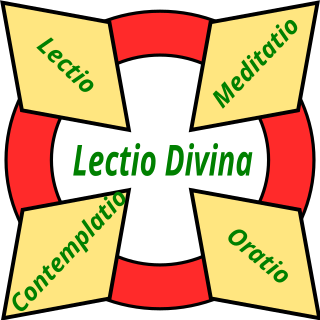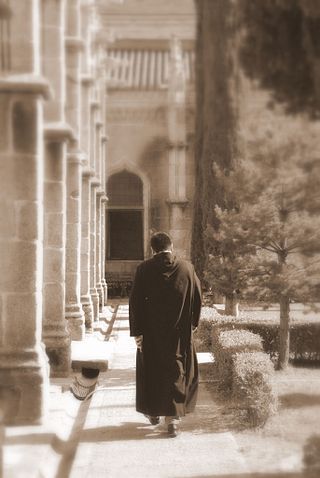Related Research Articles
Monasticism, also called monachism or monkhood, is a religious way of life in which one renounces worldly pursuits to devote oneself fully to spiritual work. Monastic life plays an important role in many Christian churches, especially in the Catholic, Orthodox and Anglican traditions as well as in other faiths such as Buddhism, Hinduism, and Jainism. In other religions, monasticism is criticized and not practiced, as in Islam and Zoroastrianism, or plays a marginal role, as in modern Judaism.
The meaning of spirituality has developed and expanded over time, and various meanings can be found alongside each other. Traditionally, spirituality referred to a religious process of re-formation which "aims to recover the original shape of man", oriented at "the image of God" as exemplified by the founders and sacred texts of the religions of the world. The term was used within early Christianity to refer to a life oriented toward the Holy Spirit and broadened during the Late Middle Ages to include mental aspects of life.
The Philokalia is "a collection of texts written between the 4th and 15th centuries by spiritual masters" of the mystical hesychast tradition of the Eastern Orthodox Church. They were originally written for the guidance and instruction of monks in "the practice of the contemplative life". The collection was compiled in the 18th century by Nicodemus the Hagiorite and Macarius of Corinth based on the codices 472, 605, 476, 628 and 629 from the library of the monastery of Vatopedi, Mount Athos.

The Trappists, officially known as the Order of Cistercians of the Strict Observance and originally named the Order of Reformed Cistercians of Our Lady of La Trappe, are a Catholic religious order of cloistered monastics that branched off from the Cistercians. They follow the Rule of Saint Benedict and have communities of both monks and nuns that are known as Trappists and Trappistines, respectively. They are named after La Trappe Abbey, the monastery from which the movement and religious order originated. The movement first began with the reforms that Abbot Armand Jean le Bouthillier de Rancé introduced in 1664, later leading to the creation of Trappist congregations, and eventually the formal constitution as a separate religious order in 1892.

Christian meditation is a form of prayer in which a structured attempt is made to become aware of and reflect upon the revelations of God. The word meditation comes from the Latin word meditārī, which has a range of meanings including to reflect on, to study, and to practice. Christian meditation is the process of deliberately focusing on specific thoughts and reflecting on their meaning in the context of the love of God.
The Regula Magistri or Rule of the Master is an anonymous sixth-century collection of monastic precepts. The text of the Rule of the Master is found in the Concordia Regularum of Benedict of Aniane, who gave it its name.

In Western Christianity, Lectio Divina is a traditional monastic practice of scriptural reading, meditation and prayer intended to promote communion with God and to increase the knowledge of God's word. In the view of one commentator, it does not treat Scripture as texts to be studied, but as the living word.
In Christianity, discernment is the ability to obtain sharp perceptions or to judge well. In the case of judgement, discernment can be psychological, moral, or aesthetic in nature.
Centering prayer is a form of Christian contemplative prayer, to center awareness on the presence of God. This modern movement in Christianity was initiated by three Trappist monks of St. Joseph's Abbey in Spencer, Massachusetts in the 1970s, Fr. William Meninger, Fr. M. Basil Pennington and Abbot Thomas Keating, in response to the growing popularity of Asian meditation methods.
Catholic spirituality includes the various ways in which Catholics live out their Baptismal promise through prayer and action. The primary prayer of all Catholics is the Eucharistic liturgy in which they celebrate and share their faith together, in accord with Jesus' instruction: "Do this in memory of me." The Catholic bishops at the Second Vatican Council decreed that "devotions should be so drawn up that they harmonize with the liturgical seasons, accord with the sacred liturgy, are in some fashion derived from it, and lead the people to it, since, in fact, the liturgy by its very nature far surpasses any of them." In accord with this, many additional forms of prayer have developed over the centuries as means of animating one's personal Christian life, at times in gatherings with others. Each of the religious orders and congregations of the Catholic church, as well as lay groupings, has specifics to its own spirituality – its way of approaching God in prayer to foster its way of living out the Gospel.

Laurence Freeman OSB is an English Benedictine monk and Catholic priest. He belongs to the Monastery of Sta Maria di Pilastrello, in Italy, of the Congregation of Monte Oliveto Maggiore. He is the Director of the World Community for Christian Meditation (WCCM), Prior of its Benedictine Oblate community and also Director of Bonnevaux, the International centre of the WCCM in France.
New Monasticism is a diverse movement, not limited to a specific religious denomination or church and including varying expressions of contemplative life. These include evangelical Christian communities such as "Simple Way Community" and Jonathan Wilson-Hartgrove's "Rutba House," European and Irish new monastic communities, such as that formed by Bernadette Flanagan, spiritual communities such as the "Community of the New Monastic Way" founded by feminist contemplative theologian Beverly Lanzetta, and "interspiritual" new monasticism, such as that developed by Rory McEntee and Adam Bucko. These communities expand upon traditional monastic wisdom, translating it into forms that can be lived out in contemporary lives "in the world."

The Abbey of Saint Mary and Saint Louis is an abbey of the Catholic English Benedictine Congregation (EBC) located in Creve Coeur, in St. Louis County, Missouri in the United States. The Abbey is an important presence in the spiritual life of the Archdiocese of St. Louis. The monks of the Abbey live their faith according to the Benedictine discipline of 'prayer and work', praying the Divine Office five times daily, celebrating daily Masses in English and Latin, and working in the two parishes under their pastoral care and in the Saint Louis Priory School, which the Abbey runs as an apostolate. The Abbey and its school sit on a 150-acre (0.61 km2) campus in west St. Louis County, in the city of Creve Coeur.

Jean LeclercqOSB, was a French Benedictine monk, the author of classic studies on Lectio Divina and the history of inter-monastic dialogue, as well as the life and theology of Saint Bernard of Clairvaux. LeClercq is perhaps best known in the English speaking world for his seminal work The Love of Learning and the Desire for God: A Study of Monastic Culture.

Monastic silence is a spiritual practice recommended in a variety of religious traditions for purposes including becoming closer to God and achieving elevated states of spiritual purity. It may be in accordance with a monk's formal vow of silence, but can also engage laity who have not taken vows, or novices who are preparing to take vows.

Prayer has been an essential part of Christianity since its earliest days. As the Middle Ages began, the monastic traditions of both Western and Eastern Christianity moved beyond vocal prayer to Christian meditation. These progressions resulted in two distinct and different meditative practices: Lectio Divina in the West and hesychasm in the East. Hesychasm involves the repetition of the Jesus Prayer, but Lectio Divina uses different Scripture passages at different times and although a passage may be repeated a few times, Lectio Divina is not repetitive in nature.

St. Andrew Abbey-Cleveland is a Benedictine monastery in Cleveland, Ohio.
Relations between the Catholic Church and Islam deals with the current attitude of the Catholic Church towards Islam, as well as the attitude of Islam towards the Catholic Church and Catholics, and notable changes in the relationship since the 20th century.
Mohammad Ali Shomali is a Muslim scholar, academic, philosopher and theologian. His religious rank is Hujjat al-Islam.
DIMMID, Dialogue Interreligieux Monastique - Monastic Interreligious Dialogue (DIM·MID), is a movement within the Benedictine and Cistercian order aimed to promote interfaith dialogue between monastic communities of different religions. Created in 1977, the movement approaches this aim through a mutual understanding and experience of each other's spirituality.
References
- ↑ "Can we talk—without anger? Advice for a calm, constructive election season from the author of Thoughts Matter". America Magazine. 2016-08-19. Retrieved 2018-07-02.
- ↑ "Mary Margaret Funk | Teachers | Spirituality & Practice". www.spiritualityandpractice.com. Retrieved 2018-07-02.
- ↑ "About... Sister Mary Margaret Funk, OSB". www.urbandharma.org. Retrieved 2018-07-02.
- ↑ Funk, Mary (2013). "Discernment Matters". Liturgical Press. Retrieved 2018-07-02.
- ↑ Funk, Mary (2010-03-01). Into the Depths: A Journey of Loss and Vocation. New York: Lantern Books. ISBN 9781590562352.
- ↑ Funk, Mary Margaret (2010-09-02). Lectio Matters: Before The Burning Bush: Through the Revelatory Texts of Scripture, Nature and Experience (1st ed.). London; New York: Continuum. ISBN 9781441151698.
- ↑ Funk, Mary Margaret (2005-01-01). Humility Matters: For Practicing the Spiritual Life. Continuum. ISBN 9780826417282.
- ↑ Funk, Mary Margaret (2004-08-31). Tools Matter for Practicing the Spiritual Life. Bloomsbury. ISBN 9780826416551.
- ↑ "Islam: What Catholics Should Know". www.liguori.org. Retrieved 2018-07-02.
- ↑ Funk, Mary; Athar, Shahid (2008-05-01). Islam Is...: An Experience of Dialogue and Devotion (2nd ed.). New York: Lantern Books. ISBN 9781590561256.
- ↑ Funk, Mary (2001-05-15). El Corazon En Paz: La Sabiduria de Los Padres Del Desierto. New York: Continuum. ISBN 9780826413239.
- ↑ Funk, Mary Margaret (1998-12-01). Thoughts Matter: The Practice of the Spiritual Life. A&C Black. ISBN 9780826411648.
- ↑ Funk, Mary (1999). "A Mind At Peace". Koorong. Retrieved 2018-07-02.